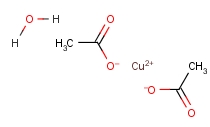Copper (II) Acetate Monohydrate
-
Post Date:
Oct 24,2013 -
Expiry Date:
Apr 22,2014 -
Detailed Description:
Cas No. :6046-93-11.Identification of the Company and the Product
Product Name:Copper (II) Acetate Monohydrate
Synonym: Cupric Acetate Monohydrate; Copper Diacetate Monohydrate.
Manufacturer:Zhucheng Kangtai Chemical Co.,Ltd
Address:Zhucheng City,Shandong,China
Emergency Call:+86-536-6013966
Fax.: +86-536-6063197
Web Site: www.kangtaichemical.com
Email: kangtaichemical@gmail.com2.Composition/ Ingredients
Chemical Name
CAS No.
EC No.
Dangerous Class
UN No.
Package Class
Symbol
R-Phrase
Copper (II) Acetate Monohydrate
6046-93-1
205-553-3
9
3077
Ⅲ
Xn
22
3.Hazards Description
Harmful to the environment.Very toxic to aquatic organisms, may have chronic adverse effects to the aquatic environment.
Potential Health Effects
May cause eye irritation.
May cause skin irritation.
Harmful if swallowed.Ingestion:May cause gastrointestinal irritation with nausea, vomiting and diarrhea. May cause liver damage.
Inhalation:May cause respiratory tract irritation.
Chronic:Chronic exposure may cause liver damage. Individuals with Wilson's disease are unable to metabolize copper. Thus, copper accumulates in various tissues and may result in liver, kidney, and brain damage.4.First-Aid Measures
Eyes: Flush eyes with plenty of water for at least 15 minutes, occasionally lifting the upper and lower eyelids. Get medical aid.
Skin:Flush skin with plenty of water for at least 15 minutes while removing contaminated clothing and shoes. Get medical aid if irritation develops or persists. Wash clothing before reuse.
Ingestion:Never give anything by mouth to an unconscious person. Get medical aid. Do NOT induce vomiting. If conscious and alert, rinse mouth and drink 2-4 cupfuls of milk or water.
Inhalation:Remove from exposure and move to fresh air immediately. If not breathing, give artificial respiration. If breathing is difficult, give oxygen. Get medical aid if cough or other symptoms appear.
Notes to Physician:
Antidote: The use of d-Penicillamine as a chelating agent should be determined by qualified medical personnel.5.Fire-Fighting Measures
-Proper Fire-Extinguishing Agents: Dry powder, carbon dioxide, foam and water (only effective for extensive fire).
-Hazardous Combustion Products:Irritating and toxic gas can be released from thermal decomposition or combustion.
-Protection for Fire-Fighting: Wear protective clothing and use self-contained breathing apparatus.6.Accidental Release Measures
Use proper personal protective equipment.Vacuum or sweep up material and place into a suitable disposal container. Clean up spills immediately. Avoid generating dusty conditions.Provide ventilation.7.Handing and Storage
Handling:
Wash thoroughly after handling. Use with adequate ventilation.
Minimize dust generation and accumulation. Avoid contact with eyes, skin, and clothing. Keep container tightly closed. Avoid ingestion and inhalation. Prevent pollutants from entering sewers,surface water, ground water and soil.Collect hazardous materials into a clean container for proper disposal. Dispose according to relevant local laws and regulations.
Storage:
Store in a tightly closed container. Store in a cool, dry, well-ventilated area away from incompatible substances.8.Exposure controls, Personal protection
Engineering Controls:
Facilities storing or utilizing this material should be equipped with an eyewash facility and a safety shower. Use adequate ventilation to keep airborne concentrations low.
Personal Protective Equipment
Eyes: Wear appropriate protective eyeglasses or chemical safety goggles.
Skin:Wear appropriate protective gloves to prevent skin exposure.
Clothing:Wear appropriate protective clothing to prevent skin exposure.
Respirators:A respiratory protection program must be followed whenever workplace conditions warrant respirator use.
9.Physical and Chemical PropertiesPhysical State: Solid
Color: dark green
Odor: none reported
pH: Not available.
Vapor Pressure: Not available.
Viscosity: Not available.
Boiling Point: 464 deg F
Freezing/Melting Point: 239 deg F
Autoignition Temperature: Not applicable.
Flash Point: Not applicable.
Explosion Limits, lower: Not available.
Explosion Limits, upper: Not available.
Decomposition Temperature: 464 F
Solubility in water: 7.2% in cold water.
Specific Gravity/Density: 1.88
Molecular Formula: Cu(C2H3O2)2.H2O
Molecular Weight: 199.59910.Reactivity and Stability
Chemical Stability:
Stable at room temperature in closed containers under normal storage and handling conditions.
Conditions to Avoid:
Incompatible materials, dust generation, excess heat, strong oxidants.
Hazardous Decomposition Products:
Irritating and toxic fumes and gases, oxides of copper.
Hazardous Polymerization: Has not been reported.11.Toxicological Information
RTECS#:
CAS# 6046-93-1: AG3500000 LD50/LC50:
CAS# 6046-93-1: Oral, rat: LD50 = 710 mg/kg.
Carcinogenicity:Copper (II) Acetate Monohydrate-Not listed by ACGIH, IARC, or NTP.
Other:See actual entry in RTECS for complete information.12.Disposal Consideration
Products which are considered hazardous for supply are classified as Special Waste and the disposal of such chemicals is covered by regulations which may vary according to location. Contact a specialist disposal company or the local waste regulator for advice. Empty containers must be decontaminated before returning for recycling.
13.Transportation Information
International Transportation Regulations:
UN Code: 3077
Packing Group:Ⅲ
Ocean Pollutants: YES
(Symbol):
 Xn Harmful
Xn Harmful N Dangerous for the environment
N Dangerous for the environmentOther Informations:
Risk Phrases:
R 22---Harmful if swallowed.
Safety Phrases:
S 24/25---Avoid contact with skin and eyes.
S 28A---After contact with skin, wash immediately with plenty of water.
S 37---Wear suitable gloves.
S 45---In case of accident or if you feel unwell, seek medical advice immediately. -
CAS Registry Number:
6046-93-1 -
Synonyms:
;Copper acetate;77408;Pigment Green 20;Verdigris [KP];Acetic acid, copper(2+) salt, monohydrate;cupric acetate monohydrate;Copperacetatemonohydrate;Acetic acid copper(II) salt monohydrate;COPPER ACETATE monohydrate;Copper(Ⅱ)acetate monohydrate;copper(2+) acetate hydrate (1:2:1);acetate, copper(2+) salt, hydrate (1:1:1); -
Molecular Formula:
C2H5CuO3 -
Molecular Weight:
140.6048 -
Molecular Structure:

-
Hazard Symbols:
Xn:Harmful;
N:Dangerous for the environment;
-
Risk Codes:
R22:;
R36/37/38:;
R50/53:;
-
Safety Description:
S36/37/39:;
S60:;
S61:;
-
Company:
Zhucheng Kangtai Chemical Co.,Ltd. [ China ] -
Contact:
Devin -
Tel:
+86-536-6013966 -
Fax:
+86-536-6063197 -
Email:
info@kangtaichemical.com